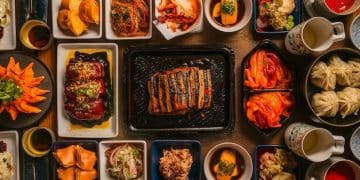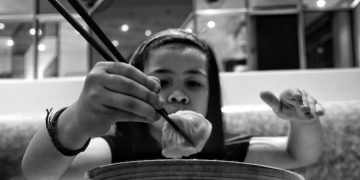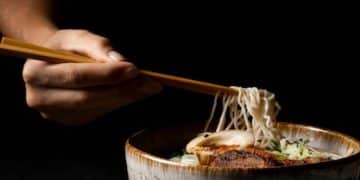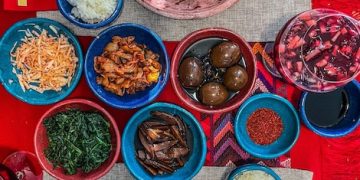Korean Drama Food Culture: Delicious Dishes in Your Favorite Shows
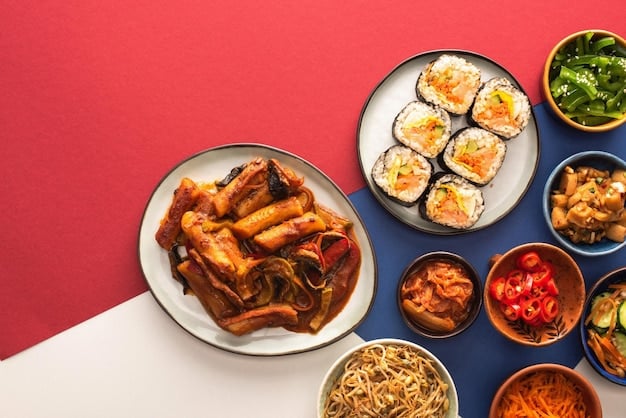
Advertisements
Korean Drama Food Culture offers a delectable glimpse into the diverse and flavorful world of Korean cuisine, showcasing iconic dishes that not only tantalize the taste buds but also play a significant role in storytelling and character development within beloved dramas.
Dive into the captivating world of Korean Drama Food Culture, where food isn’t just sustenance but a crucial ingredient in storytelling, relationships, and cultural representation. Discover the delicious dishes that have become stars in their own right, featured in your favorite shows and now ready to be explored.
Anúncios
The Alluring World of Korean Drama Food
Korean dramas, or K-dramas, have taken the world by storm, captivating audiences with their compelling storylines, charismatic actors, and a glimpse into Korean culture. Among the many elements that contribute to their appeal, food plays a remarkably significant role. So, let’s embark on a culinary journey through the captivating world of K-dramas, savoring the dishes and understanding their cultural significance.
In K-dramas, food is more than just sustenance; it’s a powerful storytelling device. It serves as a bridge between characters, a symbol of love and comfort, and a window into the rich tapestry of Korean traditions. So, are you ready to explore this food culture of Korean dramas?
Anúncios
Iconic Korean Dishes Featured on Screen
Many Korean dishes have become synonymous with K-dramas, often featured prominently in pivotal scenes. These dishes are not only visually appealing but also deeply rooted in Korean culinary traditions. Let’s explore some of the most iconic dishes that frequently grace our screens.
From sizzling stews to comforting noodle dishes, and vibrant rice creations to irresistible street food, Korean cuisine offers a symphony of flavors and textures that enhance the storytelling experience in K-dramas.
Kimchi Jjigae: A Fiery Staple
Kimchi jjigae, a spicy stew made with fermented kimchi, tofu, and often pork or seafood, is a beloved dish in Korean households and a frequent sight in K-dramas. Its vibrant red color and robust flavor make it a comforting and satisfying meal, perfect for cold days or when in need of some spice.
Bibimbap: A Colorful Delight
Bibimbap, meaning “mixed rice,” is a visually appealing and nutritious dish consisting of a bed of rice topped with an array of colorful vegetables, meat, and a fried egg. Served with a dollop of gochujang (Korean chili paste), bibimbap offers a harmonious blend of flavors and textures in every bite.

- Kimchi’s Fermented Goodness: The fermented kimchi brings complex flavors and probiotics to the stew.
- Tofu’s Soft Texture: Soft tofu complements the spicy, crunchy kimchi.
- Versatile Add-ins: Add pork, seafood, or mushrooms for a heartier stew.
- Spicy Satisfaction: The gochujang base offers a delightful kick.
Kimchi jjigae often appears during moments of bonding or comfort, showcasing the warmth and resilience of Korean culture.
Street Food Sensations in K-Dramas
Korean street food is a vibrant and diverse culinary landscape, offering a plethora of delicious and affordable snacks. K-dramas often showcase these iconic street foods, highlighting their popularity and cultural significance.
From the bustling streets of Seoul to cozy night markets, Korean street food adds a layer of authenticity and excitement to K-dramas, allowing viewers to experience the tastes and aromas of everyday Korean life.
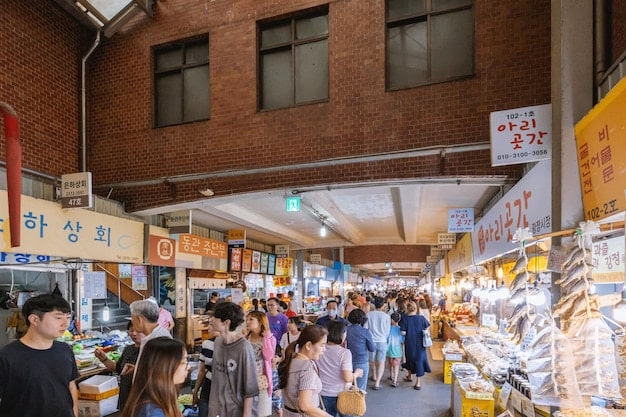
Tteokbokki: Spicy Rice Cakes
Tteokbokki, chewy rice cakes simmered in a spicy gochujang-based sauce, is a quintessential Korean street food. Its addictive flavor and satisfying texture make it a popular snack among locals and tourists alike. Tteokbokki often appears in K-dramas as a casual and communal eating experience, shared among friends or enjoyed as a quick bite.
Korean Fried Chicken: A Crispy Delight
Korean fried chicken, known for its crispy skin and variety of flavorful sauces, has become a global phenomenon. Whether it’s plain, sweet and spicy, or covered in soy garlic glaze, Korean fried chicken is a crowd-pleaser and a staple in K-drama scenes involving gatherings or celebrations.
- Crispy Coating: Double-fried for extra crispness.
- Variety of Sauces: From sweet to spicy, there’s a flavor for everyone.
- Perfect for Sharing: Often enjoyed in groups with drinks.
- Global Phenomenon: Popular worldwide due to its unique taste.
The appeal of Korean street food in dramas extends beyond the delicious treats. It’s about the complete atmospheric and social experience they offer.
Royal Cuisine and Traditional Foods
Beyond street food and everyday dishes, K-dramas also offer glimpses into the world of royal cuisine and traditional Korean foods. These dishes are often elaborate and meticulously prepared, reflecting the rich history and cultural heritage of Korea.
From historical dramas set in ancient kingdoms to modern-day stories celebrating traditions, K-dramas provide a window into the refined and symbolic world of Korean royal cuisine.
Han Jeong Sik: A Royal Feast
Han Jeong Sik, a traditional Korean full-course meal, is a lavish spread of various banchan (side dishes), rice, soup, and main courses. Each dish is carefully crafted with seasonal ingredients and presented with elegance and precision. Han Jeong Sik showcases the artistry and sophistication of Korean cuisine, often featured in historical K-dramas to depict royal banquets or important ceremonial events.
Medicinal Cuisine: Food as Medicine
Korean cuisine places great emphasis on the medicinal properties of food. Many traditional dishes incorporate ingredients believed to promote health and well-being. For example, ginseng chicken soup (samgyetang) is a popular dish consumed during the summer months, believed to replenish energy and vitality.
- Balance and Harmony: Traditional meals emphasize balance of flavors and ingredients.
- Seasonal Ingredients: Fresh, seasonal products are cornerstones in cooking.
- Medicinal Properties: Incorporate healthy elements into meals.
- Historical Significance: Reflect culinary history and traditions.
These dishes often symbolize health, prosperity, and respect for tradition, adding depth and meaning to the narrative.
Food as a Symbol of Love and Comfort
In K-dramas, food often transcends its basic function and becomes a powerful symbol of love, care, and comfort. Characters express their emotions through food, sharing meals, cooking for loved ones, and offering comforting dishes during times of need.
From romantic gestures to familial bonds, food acts as a conduit for emotions, strengthening relationships and conveying unspoken feelings in K-dramas.
Cooking for Loved Ones: An Act of Affection
Cooking for someone is a common way to express affection in K-dramas. Whether it’s a mother preparing a home-cooked meal for her children, or a romantic interest whipping up a special dish for their beloved, the act of cooking is seen as a gesture of love and care.
Sharing Meals: Building Bonds
Sharing meals is another important aspect of Korean culture that is frequently depicted in K-dramas. Eating together fosters a sense of community and togetherness, allowing characters to bond over food and share their thoughts and feelings. From boisterous family dinners to intimate meals between couples, sharing food is a way to strengthen relationships and create lasting memories.
- Cooking: A deliberate act of care and empathy.
- Sharing: Promotes togetherness and companionship.
- Comfort: Food is used as a refuge when life is difficult.
- Traditions: Reinforces meaningful cultural customs.
Whether it’s a simple bowl of noodles or an elaborate feast, food becomes an expression of the characters’ emotions, adding warmth and depth to the story.
Modern Twists and Fusion Cuisine in K-Dramas
While traditional Korean dishes hold a special place in K-dramas, modern twists and fusion cuisine are also gaining popularity, reflecting the evolving culinary landscape of Korea. K-dramas often showcase innovative dishes that blend Korean flavors with international influences, appealing to a younger generation with adventurous palates.
These modern interpretations add a touch of novelty and excitement to K-dramas, showcasing the dynamic and creative spirit of Korean cuisine. For example, expect the unexpected in popular dramas.
Korean-Western Fusion: A Culinary Mashup
Korean-Western fusion dishes are becoming increasingly common in K-dramas, featuring creative combinations of Korean and Western ingredients and techniques. For example, a Korean-style burger might feature bulgogi (marinated beef) as the patty, topped with kimchi slaw and gochujang mayo.
Desserts and Sweet Treats: A Modern Indulgence
K-dramas also showcase a wide array of desserts and sweet treats, from traditional Korean sweets like yakgwa (honey cookies) to modern creations like bingsu (shaved ice) with trendy toppings. These desserts add a touch of sweetness and indulgence to the drama, often enjoyed during celebratory moments or as a comforting treat after a long day.
- Innovation: Blending customs for new experiences.
- Global Appeal: Drawing inspiration from worldwide palettes.
- Visually Stunning: These are attractive dishes.
- Younger Generation: Caters to a more youthful consumer.
These contemporary twists reflect the creativity and innovation that defines modern Korean cuisine.
Experiencing Korean Drama Food Culture in the US
For those captivated by the Korean Drama Food Culture, experiencing these dishes in the US is becoming increasingly accessible. Korean restaurants are popping up in cities across the country, offering a diverse range of authentic and fusion dishes. Additionally, many supermarkets now carry essential Korean ingredients, allowing enthusiasts to recreate their favorite K-drama meals at home.
Whether dining out or cooking at home, exploring the Korean Drama Food Culture is a delicious and immersive way to connect with Korean culture and savor the flavors that have captivated audiences worldwide.
- Restaurant Boom: Easily accessible Korean eateries are growing in popularity.
- Cooking at Home: Preparing traditional foods is a great hobby.
- Cultural Bridges: The sharing of culture brings people together.
- Flavors Abound: Savory foods from favorite shows come alive.
Taking part in cultural enrichment allows everyone to experience K-dramas in a personal way.
| Key Point | Brief Description |
|---|---|
| 🍲 Iconic Dishes | Kimchi jjigae and bibimbap are must-try dishes often showcased in dramas. |
| 🍢 Street Food | Tteokbokki and Korean fried chicken are popular snacks seen in K-drama scenes. |
| 👑 Royal Cuisine | Han Jeong Sik portrays the elegance of royal banquets and traditions. |
| 💖 Food & Emotions | Food symbolizes love, comfort, and connection between characters in K-dramas. |
Frequently Asked Questions (FAQs)
▼
Kimchi jjigae is a spicy, flavorful stew made with fermented kimchi, tofu, and often includes pork or seafood. It’s a popular comfort food enjoyed any time of year.
▼
Korean fried chicken is known for its extra crispy skin, achieved through a double-frying method, and its wide variety of sweet, savory, and spicy sauces.
▼
Food in K-dramas is more than sustenance. It symbolizes love, comfort, and connection, and plays a notable part in relationship dynamics and storytelling.
▼
Bibimbap is a mixed rice dish with seasoned vegetables, meat, a fried egg, and gochujang (chili paste). It offers a colorful and balanced blend of nutrition and flavors.
▼
You can explore Korean food culture in the US by visiting Korean restaurants, purchasing Korean ingredients at supermarkets, or even trying to cook K-drama inspired dishes at home.
Conclusion
From the humble street food to the elaborate Korean royal cuisine, K-dramas serve as a cultural ambassador, bringing the flavors and traditions of Korea to global audiences. This exploration into Korean Drama Food Culture not only satisfies the appetite but enriches our understanding of interpersonal relationship through these stories.

